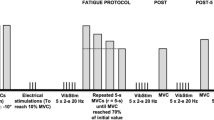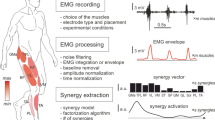Abstract
State-space control of myoelectric devices and real-time visualization of muscle forces in virtual rehabilitation require measuring or estimating muscle dynamic states: neuromuscular activation, tendon force and muscle length. This paper investigates whether regular (KF) and extended Kalman filters (eKF), derived directly from Hill-type muscle mechanics equations, can be used as real-time muscle state estimators for isometric contractions using raw electromyography signals (EMG) as the only available measurement. The estimators’ amplitude error, computational cost, filtering lags and smoothness are compared with usual EMG-driven analysis, performed offline, by integrating the nonlinear Hill-type muscle model differential equations (offline simulations—OS). EMG activity of the three triceps surae components (soleus, gastrocnemius medialis and gastrocnemius lateralis), in three torque levels, was collected for ten subjects. The actualization interval (AI) between two updates of the KF and eKF was also varied. The results show that computational costs are significantly reduced (70x for KF and 17\(\times \) for eKF). The filtering lags presented sharp linear relationships with the AI (0–300 ms), depending on the state and activation level. Under maximum excitation, amplitude errors varied in the range 10–24% for activation, 5–8% for tendon force and 1.4–1.8% for muscle length, reducing linearly with the excitation level. Smoothness, measured by the ratio between the average standard variations of KF/eKF and OS estimations, was greatly reduced for activation but converged exponentially to 1 for the other states by increasing AI. Compared to regular KF, extended KF does not seem to improve estimation accuracy significantly. Depending on the particular application requirements, the most appropriate KF actualization interval can be selected.





Similar content being viewed by others
References
Anderson BDO, Moore JN (2005) Optimal filtering. Dover Publications, New York
Artemiadis P, Kyriakopoulos K (2010) An emg-based robot control scheme robust to time-varying EMG signal features. IEEE Trans Inf Technol Biomed 14(3):582–588. doi:10.1109/TITB.2010.2040832
Buchanan TS, Lloyd DG, Manal K, Besier TF (2004) Neuromusculoskeletal modeling: estimation of muscle forces and joint moments and movements from measurements of neural command. J Appl Biomech 20(4):367–395
Clancy E, Hogan N (1994) Single site electromyograph amplitude estimation. IEEE Trans Biomed Eng 41(2):159–167
Corbett E, Kording K, Perreault E (2013) Real-time evaluation of a noninvasive neuroprosthetic interface for control of reach. IEEE Trans Neural Syst Rehabil Eng 21(4):674–683. doi:10.1109/TNSRE.2013.2251664
Delp SL, Anderson FC, Arnold AS, Loan P, Habib A, John CT, Guendelman E, Thelen DG (2007) Opensim: open-source software to create and analyze dynamic simulations of movement. IEEE Trans Biomed Eng 54(11):1940–1950
Ding Q, Xiong A, Zhao X, Han J (2011a) A novel EMG-driven state space model for the estimation of continuous joint movements. In: 2011 IEEE international conference on systems, man, and cybernetics (SMC), pp 2891–2897. doi:10.1109/ICSMC.2011.6084104
Ding Q, Zhao X, Xiong A, Han J (2011b) A novel motion estimate method of human joint with EMG-driven model. In: 2011 5th international conference on bioinformatics and biomedical engineering, (iCBBE), pp 1–5. doi:10.1109/icbbe.2011.5780185
Dutta A, Koerding K, Perreault E, Hargrove L (2011) Sensor-fault tolerant control of a powered lower limb prosthesis by mixing mode-specific adaptive Kalman filters. In: 2011 annual international conference of the IEEE on engineering in medicine and biology society, EMBC, pp 3696–3699. doi:10.1109/IEMBS.2011.6090626
Faisal AA, Selen LP, Wolpert DM (2008) Noise in the nervous system. Nat Rev Neurosci 9(4):292–303
Farina D, Merletti R (2000) Comparison of algorithms for estimation of emg variables during voluntary isometric contractions. J Electromyogr Kinesiol 10(5):337–349. doi:10.1016/S1050-6411(00)00025-0
Farina D, Jiang N, Rehbaum H, Holobar A, Graimann B, Dietl H, Aszmann O (2014) The extraction of neural information from the surface EMG for the control of upper-limb prostheses: emerging avenues and challenges. IEEE Trans Neural Syst Rehabil Eng 22(4):797–809. doi:10.1109/TNSRE.2014.2305111
Flanagan JR, Wing AM (1997) The role of internal models in motion planning and control: evidence from grip force adjustments during movements of hand-held loads. J Neurosci 17(4):1519–1528
Fleischer C, Hommel G (2008) A human–exoskeleton interface utilizing electromyography. IEEE Trans Robot 24(4):872–882. doi:10.1109/TRO.2008.926860
Grewal MS, Andrews AP (2001) Theory and practice using MATLAB, 2nd edn. Wiley, Hoboken
Grush R (2004) The emulation theory of representation: motor control, imagery, and perception. Behav Brain Sci 27(03):377–396
Kalman RE, Bucy RS (1961) New results in linear filtering and prediction theory. J Basic Eng 83(1):95–108
Liu L, Liu P, Clancy E, Scheme E, Englehart K (2013) Electromyogram whitening for improved classification accuracy in upper limb prosthesis control. IEEE Trans Neural Syst Rehabil Eng 21(5):767–774. doi:10.1109/TNSRE.2013.2243470
Lloyd DG, Besier TF (2003) An EMG-driven musculoskeletal model to estimate muscle forces and knee joint moments in vivo. J Biomech 36(6):765–776. doi:10.1016/S0021-9290(03)00010-1
Manal K, Gonzalez RV, Lloyd DG, Buchanan TS (2002) A real-time EMG-driven virtual arm. Comput Biol Med 32(1):25–36
Manal K, Gravare-Silbernagel K, Buchanan TS (2012) A real-time EMG-driven musculoskeletal model of the ankle. Multibody Syst Dyn 28(1–2):169–180. doi:10.1007/s11044-011-9285-4
Matisko P, Havlena V (2010) Noise covariances estimation for Kalman filter tuning. Adapt Learn Control Signal Process 10:31–36
Matsubara T, Morimoto J (2013) Bilinear modeling of EMG signals to extract user-independent features for multiuser myoelectric interface. IEEE Trans Biomed Eng 60(8):2205–2213. doi:10.1109/TBME.2013.2250502
Menegaldo L (2012) Exploring possibilities for real-time muscle dynamics state estimation from EMG signals. In: 2012 4th IEEE RAS EMBS international conference on biomedical robotics and biomechatronics (BioRob), pp 1850–1855. doi:10.1109/BioRob.2012.6290712
Menegaldo L (2013) Quadriceps dynamic model tuning from isokinetic knee torque using optimization: a numerical simulation study. In: SEMNI congress on numerical methods in engineering, p a136
Menegaldo LL, de Oliveira LF (2009) Effect of muscle model parameter scaling for isometric plantar flexion torque prediction. J Biomech 42(15):2597–2601. doi:10.1016/j.jbiomech.2009.06.043
Menegaldo LL, Oliveira LF (2012) The influence of modeling hypothesis and experimental methodologies in the accuracy of muscle force estimation using EMG-driven models. Multibody Syst Dyn 28(1–2):21–36. doi:10.1007/s11044-011-9273-8
Minka T (2015) Lightspeed toolbox. http://research.microsoft.com/en-us/um/people/minka/software/lightspeed/. Accessed 2015-02-12
Nolan L, Kerrigan DC (2004) Postural control: toe-standing versus heel-toe standing. Gait Posture 19(1):11–15
Novak D, Robert R (2015) A survey of sensor fusion methods in wearable robotics. Robot Auton Syst 73 (2015):155–170
Nowak DA, Glasauer S, Hermsdörfer J (2013) Force control in object manipulation—a model for the study of sensorimotor control strategies. Neurosci Biobehav Rev 37(8):1578–1586
Ostry DJ, Feldman AG (2003) A critical evaluation of the force control hypothesis in motor control. Exp Brain Res 153(3):275–288
Panzieri S, Pascucci F, Ulivi G (2002) An outdoor navigation system using GPS and inertial platform. IEEE/ASME Trans Mechatron 7(2):134–142. doi:10.1109/TMECH.2002.1011250
Press W, Teukolsky S, Vetterling W, Flannery B (1992) Numerical recipes in C, 2nd edn. Cambridge University Press, Cambridge
Rosen J, Brand M, Fuchs M, Arcan M (2001) A myosignal-based powered exoskeleton system. IEEE Trans Syst Man Cybern Part A Syst Hum 31(3):210–222
Sanger TD (2007) Bayesian filtering of myoelectric signals. J Neurophysiol 97(2):1839–1845. doi:10.1152/jn.00936.2006
Schwartz AB (2016) Movement: how the brain communicates with the world. Cell 164(6):1122–1135
Scott SH (2004) Optimal feedback control and the neural basis of volitional motor control. Nat Rev Neurosci 5(7):532–546
Shadmehr R, Krakauer JW (2008) A computational neuroanatomy for motor control. Exp Brain Res 185(3):359–381
Todorov E (2008) General duality between optimal control and estimation. In: 47th IEEE conference on decision and control, 2008, CDC 2008. IEEE, pp 4286–4292
Todorov E, Jordan MI (2002) Optimal feedback control as a theory of motor coordination. Nat Neurosci 5(11):1226–1235
Tucker M, Olivier J, Pagel A, Bleuler H, Bouri M, Lambercy O, Millan JD, Riener R, Vallery H, Gassert R (2015) Control strategies for active lower extremity prosthetics and orthotics: a review. J Neuroeng Rehabilit 12(1):1. doi:10.1186/1743-0003-12-1, http://www.jneuroengrehab.com/content/12/1/1
Vallery H, van Asseldonk E, Buss M, van der Kooij H (2009) Reference trajectory generation for rehabilitation robots: complementary limb motion estimation. IEEE Trans Neural Syst Rehabil Eng 17(1):23–30. doi:10.1109/TNSRE.2008.2008278
van der Heijden F, Duin R, de Ridder D, Tax DMJ (2005) Classification, parameter estimation and state estimation: an engineering approach using MATLAB. Signal processing series. Wiley, Hoboken
Wolpert DM, Ghahramani Z (2000) Computational principles of movement neuroscience. Nat Neurosci 3:1212–1217
Wolpert DM, Kawato M (1998) Multiple paired forward and inverse models for motor control. Neural Netw 11(7):1317–1329
Zajac F (1989) Muscle and tendon: properties, models, scaling, and application to biomechanics and motor control. Crit Rev Biomed Eng 17(4):359–411
Zhang Q, Hayashibe M, Guiraud D (2011) Muscle fatigue tracking based on stimulus evoked EMG and adaptive torque prediction. In: 2011 IEEE international conference on robotics and automation (ICRA), pp 1433–1438. doi:10.1109/ICRA.2011.5980087
Acknowledgements
The author is gratefully acknowledged to Brazilian Federal Agencies CAPES, CNPq and FINEP, as well as to Rio de Janeiro State Agency FAPERJ, for financial support. The author thanks Prof. Liliam Oliveira for helping with data collection and statistical analysis.
Author information
Authors and Affiliations
Corresponding author
Rights and permissions
About this article
Cite this article
Menegaldo, L.L. Real-time muscle state estimation from EMG signals during isometric contractions using Kalman filters. Biol Cybern 111, 335–346 (2017). https://doi.org/10.1007/s00422-017-0724-z
Received:
Accepted:
Published:
Issue Date:
DOI: https://doi.org/10.1007/s00422-017-0724-z




